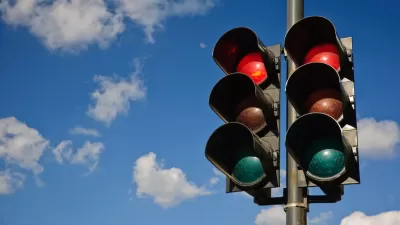After completing an eight-year study of traffic collisions, the Seattle Department of Transportation realized that one way to immediately improve traffic safety would be to improve signalization an key intersections.

Ryan Packer reports on a new commitment in Seattle to reprioritize traffic light replacements as a component of the Seattle Department of Transportation's (SDOT) Vizion Zero initiative. Here Packer sets the context:
When the Seattle Department of Transportation (SDOT) announced the end of an eight-year study on traffic collision data, it had a very comprehensive set of data on where collisions took place, what modes were involved, and how the collisions occurred. The big question was: how would the department begin to apply the data across the city to reduce those collisions?
Packer follows up a post on the SDOT Blog announcing that the agency has targeted traffic signalization as a priority project in response to the data produced by that study. "Not only will they be using that more robust set of data to determine where to add signals, they will also be prioritizing the improvement of existing traffic signals to improve the left turn movements," according to Ryan Packer. SDOT has already identified ten highest priority intersections for new traffic signals. According to Packer, the whole process reflects "a big step toward a data-driven approach to the day-to-day business that SDOT engages in all the time: routine maintenance, system upgrades, and safety improvements."
FULL STORY: SDOT To Reprioritize Traffic Light Replacement

Study: Maui’s Plan to Convert Vacation Rentals to Long-Term Housing Could Cause Nearly $1 Billion Economic Loss
The plan would reduce visitor accommodation by 25,% resulting in 1,900 jobs lost.

North Texas Transit Leaders Tout Benefits of TOD for Growing Region
At a summit focused on transit-oriented development, policymakers discussed how North Texas’ expanded light rail system can serve as a tool for economic growth.

Why Should We Subsidize Public Transportation?
Many public transit agencies face financial stress due to rising costs, declining fare revenue, and declining subsidies. Transit advocates must provide a strong business case for increasing public transit funding.

How to Make US Trains Faster
Changes to boarding platforms and a switch to electric trains could improve U.S. passenger rail service without the added cost of high-speed rail.

Columbia’s Revitalized ‘Loop’ Is a Hub for Local Entrepreneurs
A focus on small businesses is helping a commercial corridor in Columbia, Missouri thrive.

Invasive Insect Threatens Minnesota’s Ash Forests
The Emerald Ash Borer is a rapidly spreading invasive pest threatening Minnesota’s ash trees, and homeowners are encouraged to plant diverse replacement species, avoid moving ash firewood, and monitor for signs of infestation.
Urban Design for Planners 1: Software Tools
This six-course series explores essential urban design concepts using open source software and equips planners with the tools they need to participate fully in the urban design process.
Planning for Universal Design
Learn the tools for implementing Universal Design in planning regulations.
Ascent Environmental
Borough of Carlisle
Institute for Housing and Urban Development Studies (IHS)
City of Grandview
Harvard GSD Executive Education
Toledo-Lucas County Plan Commissions
Salt Lake City
NYU Wagner Graduate School of Public Service




























